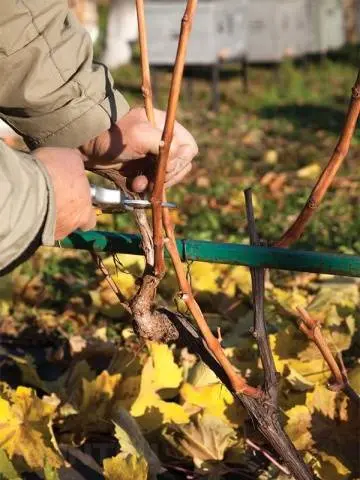Contents
Not all varieties of grapes are grown in order to obtain a bountiful harvest, sometimes the quality of the fruit is more valuable than their quantity. Raisin grapes are a variety that is more pleasant to eat than to grow. This culture is capricious, requiring a special approach, constant attention and complex care. But the harvest of Raisins is definitely pleasing: the clusters are very large and beautiful, the berries are oval, deep in color, with excellent taste and strong aroma. This variety is not recommended for beginners, it is recommended to buy Raisin cuttings for experienced growers.
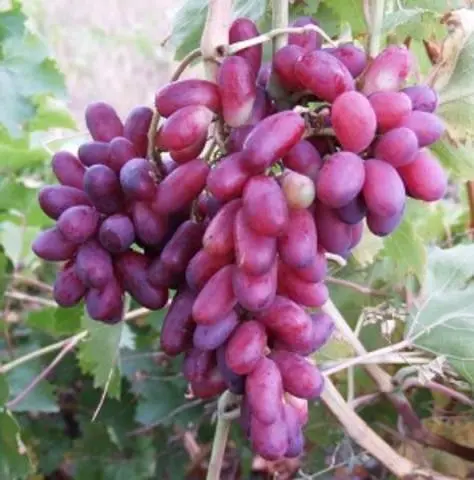
A detailed description of the Izyuminka grape variety, with reviews from gardeners and photos of bunches, is in this article. Below you can read about the strengths and weaknesses of a large-fruited variety, learn about how best to grow capricious grapes and how to care for them.
Culture features
Grape variety Izyuminka is considered table. It is also an early red grape. It is easy to recognize this variety by large finger-shaped berries of rich wine color.
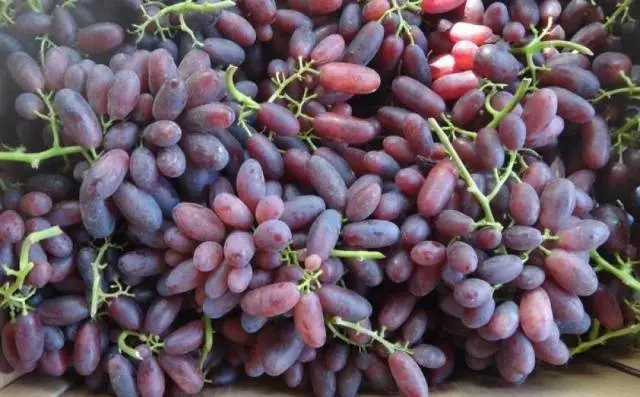
The hybrid is zoned for Moldova, Ukraine and the southern regions of Our Country. But even in the climate of these areas, the Raisin should be covered for the winter, since the variety is very thermophilic.
About grapes Izyuminka became known quite recently, because it was bred several years ago. The origin of the variety is Ukrainian, its “homeland” was the institute of viticulture “Magarach”, located on the territory of Ukraine. The “parents” for the new hybrid were the varieties Chaush and Cardinal, and the scientific name of the species obtained as a result of crossing is XVII-241.
It is no coincidence that the new hybrid received a more poetic name “Zest”. Winegrowers noticed an amazing feature of the variety: if you do not rush to harvest and leave a few uncut clusters on the vine, in a couple of weeks they will turn into wonderful raisins.
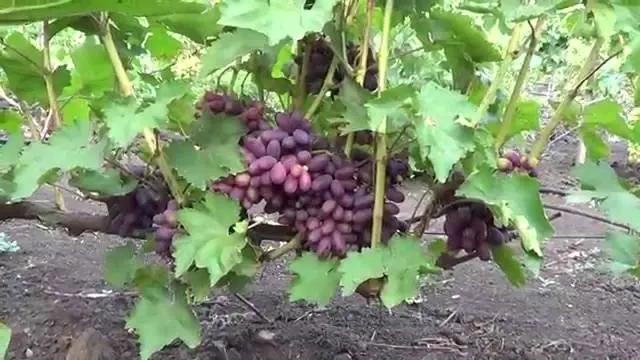
Description of the variety Izyuminka:
- early ripening of grapes – until the full maturity of the fruit from the moment of bud break, at least 110-115 days must pass;
- the bushes are very tall, the vine is distinguished by good and fast growth, it ripens almost along the entire length;
- the inflorescences on the raisin bushes are only female, that is, the flowers do not have stamens and cannot self-pollinate (therefore, next to the variety in question, it is necessary to plant another grape with the same early ripening dates and bisexual or male inflorescences);
- the grapes are pollinated well, the set of clusters is normal;
- bunches of Raisins are large, loose, in the shape of a cone;
- the average weight of one bunch is 400-500 grams;
- when pruning and rationing, one bunch is left on each shoot;
- “pea” of berries is not typical for the variety – all fruits are approximately the same in size and shape;
- the berries are very large – about three centimeters in length and weighing 10 grams;
- the shape of the fruit is oblong, strongly elongated (shown in the photo);

- the color of the berries is dark, saturated, red-violet;
- the pulp is dense, crispy, marmalade structure;
- the taste of Raisins is wonderful, balanced, sweet;
- sugar content in grapes at the level of 15-20%;
- the peel on the berries is dense, but in the process of eating it is practically not felt;
- the yield of grapes Raisin is highly dependent on the age of the vine and the care of the bush;
- it is believed that the yield of this variety is low: in the first years it is possible to remove only a few kilograms from the bush, in the future, the figures can reach 15-18 kg from each plant;
- with proper care, the vine begins to bear fruit only in the third or fourth year after planting;
- The zest is not cut off in the first years after planting – this variety differs from many others;
- frost resistance in grapes is weak – without shelter, the vine is able to withstand a temperature drop to a maximum of -12-15 degrees;
- the variety has practically no resistance to diseases and pests, so the main work of the grower will be in preventive treatments of the vine.
Advantages and disadvantages
Laudatory reviews about the variety Izyuminka are rare: the grower must be prepared for regular spraying of the vine and the constant struggle for the integrity and health of the bush. As mentioned above, many people like the appearance and taste of this grape, but growing Raisins is a dubious pleasure.
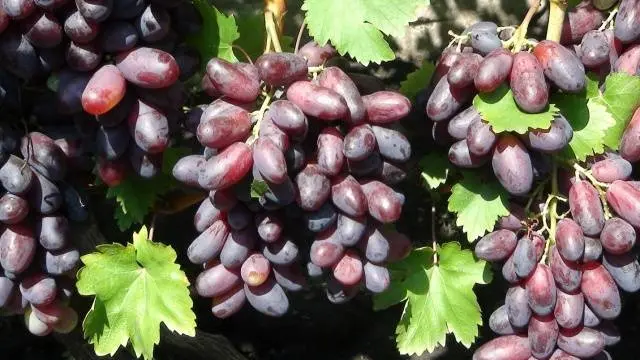
The variety has several advantages:
- excellent presentation;
- large sizes of clusters and berries;
- excellent taste and high sugar content in fruits;
- a large percentage of vitamins and valuable trace elements in fruits;
- suitability of grapes for transportation and long-term storage (in cellars or in refrigerators).
Listing the strengths of the Izyuminka grape, one cannot fail to mention the real possibility of increasing crop volumes through proper agricultural technology and intensive care.
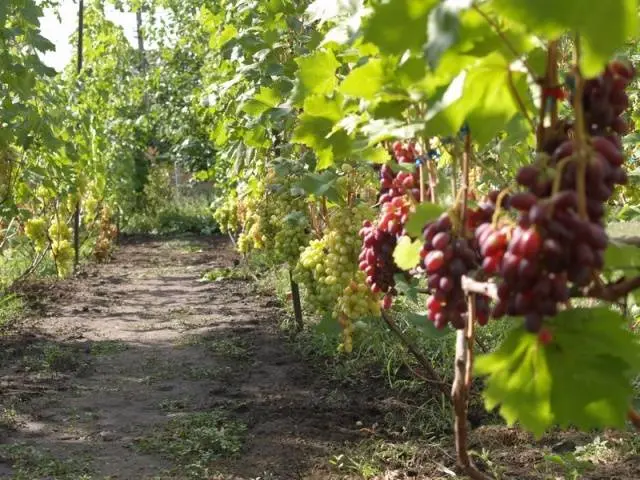
Unfortunately, this beautiful and tasty grape also has drawbacks, and they are very significant. All the disadvantages of the variety are primarily associated with its capriciousness. The following factors are most upsetting for growers:
- whimsicalness to the composition of the soil and its nutritional value – on scarce soils, the Raisin bears fruit very poorly, and the leaves on the vine become small;
- weak immunity, due to which, throughout the warm season, winegrowers have to fight against various pests and infections;
- low frost resistance – the vine without shelter can withstand a temperature drop of only -12 degrees;
- late fruiting – only six years after planting, you can wait for the first normal harvest;
- low yields, strongly related to the amount of fertilizer and regular care.
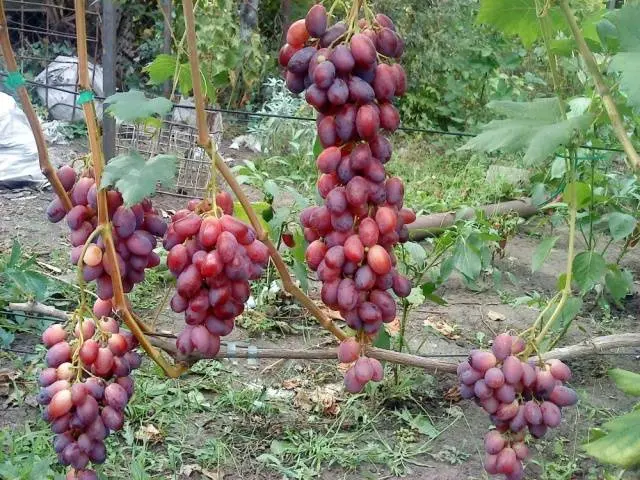
In this situation, even more frequent pruning does not help, as trimmed bushes grow even faster and more abundantly. All this leads to the depletion of the vine and reduce the yield of the entire vineyard.
Growing rules
Izyuminka grapes will require maximum output from the gardener, but in return they will please with very large and incredibly tasty berries on massive clusters. For beginners, it is best not to choose this variety as a first experience, Raisin is more suitable for experienced growers with enough time.
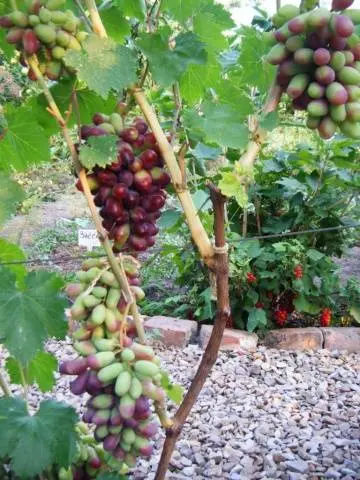
Planting cuttings
Raisin grapes love warmth and sun, so it should be planted on the south side, no closer than a meter from the wall of a building or fence. Such a planting will protect the vine from the icy north wind and prevent freezing of the roots during the period of snow melting or sudden temperature fluctuations.
The roots of the Raisins are not too long, their main part lies at a depth of 30-40 cm – this is where the most fertile layer of the earth should be. The optimal dimensions of the landing pit are 0,6×0,6×0,6 meters.

A 20-centimeter layer of broken brick or rubble is laid at the bottom of the pit, then fertile soil is poured out, consisting of soil, sand, compost, humus, ash and mineral fertilizers.
Along the edges of each pit, it is recommended to install a vertical 50-centimeter pipe section – it will be very convenient to water the grapes through these wells.
How to care
A capricious variety needs careful care – this is the only way to increase the yield of grapes and wait for at least some kind of result.
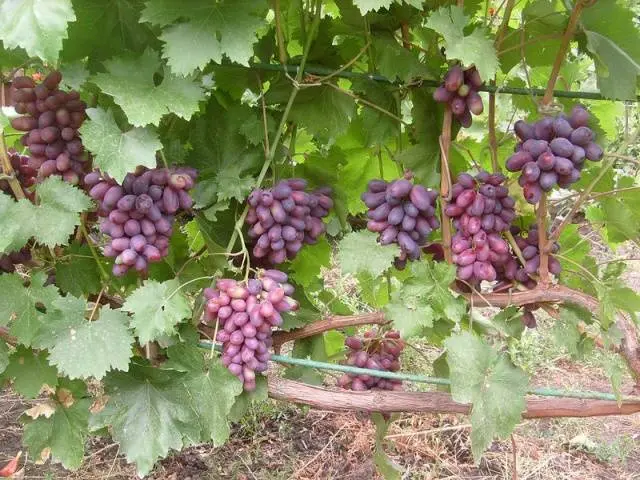
You need to take care of a vineyard with a Zest like this:
- water the bushes, using special systems or pipe-wells, will have to be done regularly, especially during periods of drought. It is also important not to overdo it with irrigation, as the Raisin is prone to the development of various fungal infections, and high humidity contributes to their spread.
- To protect the vineyard from infections, pests and overheating of the root system, it is recommended use mulch. Organic mulch in the form of sawdust, peat, humus or straw will not only protect the Raisin, but also become a source of nutrients for the grapes.

- feed variety Izyuminka will have to be frequent and plentiful, since the crop bears fruit very poorly on poor soils. Every three years in autumn it is recommended to apply a large amount of cow manure (about 7 kg per square meter). During the summer season, you can feed the grapes several times with special mineral complexes or use a phosphorus-potassium mixture. In the spring, Raisin responds well to a small portion of nitrogen, it is applied before and after flowering.
- prune the vine better twice a season: in spring and autumn. This schedule is recommended due to the rapid growth of the bush and the strong growth of young shoots. Pruning is used medium or long, leaving 5 to 8 buds on each shoot. Before sheltering for the winter, it is better not to cut the Raisin grapes, as this will give rise to an even greater growth of shoots that can violate the integrity of the shelter.

- Preventive spraying should become a habit for those who have planted the Zyuminka variety on their site. You will have to fight with mildew, oidium, bacterial cancer, gray mold, anthracnose, escoriosis. In addition to diseases, large-fruited grapes are also lured by various pests (grape and spider mites, phylloxera). Bordeaux mixture can be used for spraying at least three times per season. It is recommended to start as early as possible – with the first stable heat. If the infection of the vine has occurred, you will have to remove all the ovaries and leaves and thoroughly irrigate the bush with a fungicide – this is the only way to save the Raisin.
- shelter non-frost-resistant grapes are a must, since even in the warm Crimea, cases of freezing Raisins are not uncommon. Collecting a lot of young and old shoots and tying them up is still fun, but it needs to be done. It is effective to cover the vine with agrofibre and protect the roots with a thick layer of mulch.
Write Your Review
Conclusion

Grapes of the Zyuminka variety cannot be called universal – it is far from suitable for everyone. This culture loves heat and sun, does not tolerate frost, often gets sick, needs regular feeding, watering, careful pruning – the grower will have a lot of trouble. The reward for long labors will be large clusters with huge berries of an interesting firm and amazing rich color.












